标签:lib 影响 tool pack ack 坐标 代码 har sift
一、SIFT提出的目的和意义
二、SIFT的特征简介
三、SIFT算法实现步骤简述
四、图像集
五、SIFT算法代码实现
六、SIFT实验总结
一、SIFT提出的目的和意义
1999年David G.Lowe教授总结了基于特征不变技术的检测方法,在图像尺度空间基础上,提出了对图像缩放、旋转保持不变性的图像局部特征描述算子-SIFT(尺度不变特征变换),该算法在2004年被加以完善。
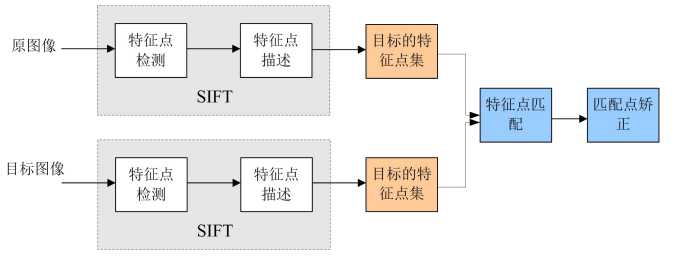
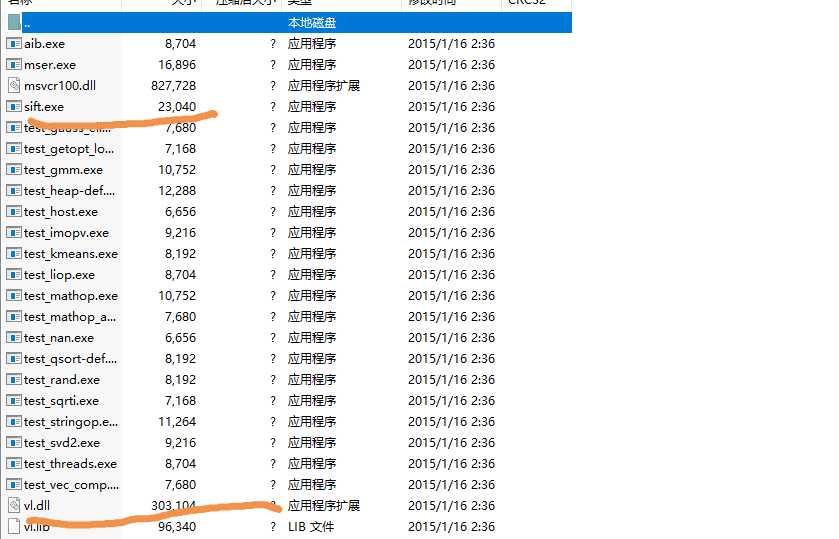


图2
代码:
1 # -*- coding: utf-8 -*- 2 from PIL import Image 3 from pylab import * 4 from PCV.localdescriptors import sift 5 from PCV.localdescriptors import harris 6 7 # 添加中文字体支持 8 from matplotlib.font_manager import FontProperties 9 font = FontProperties(fname=r"c:\windows\fonts\SimSun.ttc", size=14) 10 11 imname = ‘siftt/24.jpg‘ 12 im = array(Image.open(imname).convert(‘L‘)) 13 sift.process_image(imname, ‘24.sift‘) 14 l1, d1 = sift.read_features_from_file(‘24.sift‘) 15 16 figure() 17 gray() 18 subplot(131) 19 sift.plot_features(im, l1, circle=False) 20 title(u‘SIFT特征‘,fontproperties=font) 21 subplot(132) 22 sift.plot_features(im, l1, circle=True) 23 title(u‘用圆圈表示SIFT特征尺度‘,fontproperties=font) 24 25 # 检测harris角点 26 harrisim = harris.compute_harris_response(im) 27 28 subplot(133) 29 filtered_coords = harris.get_harris_points(harrisim, 6, 0.1) 30 imshow(im) 31 plot([p[1] for p in filtered_coords], [p[0] for p in filtered_coords], ‘*‘) 32 axis(‘off‘) 33 title(u‘Harris角点‘,fontproperties=font) 34 35 show()
原图

运行结果:
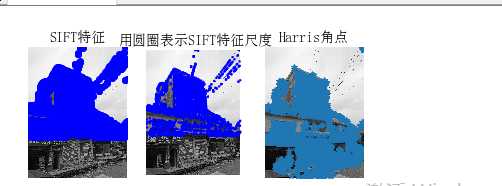
小结:由图看出,sift算法检测出来的特征点比harris角点算法检测出的角点多。sift算法测出来的特征点大多数都是重合的。
2、图像集里的所有图像的sift特征提取
代码:
1 # -*- coding: utf-8 -*- 2 from PIL import Image 3 from pylab import * 4 from PCV.localdescriptors import sift 5 from PCV.localdescriptors import harris 6 from PCV.tools.imtools import get_imlist # 导入原书的PCV模块 7 8 # 添加中文字体支持 9 from matplotlib.font_manager import FontProperties 10 font = FontProperties(fname=r"c:\windows\fonts\SimSun.ttc", size=14) 11 12 # 获取project2_data文件夹下的图片文件名(包括后缀名) 13 filelist = get_imlist(‘siftt/‘) 14 15 for infile in filelist: # 对文件夹下的每张图片进行如下操作 16 print(infile) # 输出文件名 17 18 im = array(Image.open(infile).convert(‘L‘)) 19 sift.process_image(infile, ‘infile.sift‘) 20 l1, d1 = sift.read_features_from_file(‘infile.sift‘) 21 i=1 22 23 figure(i) 24 i=i+1 25 gray() 26 27 subplot(131) 28 sift.plot_features(im, l1, circle=False) 29 title(u‘SIFT特征‘,fontproperties=font) 30 31 subplot(132) 32 sift.plot_features(im, l1, circle=True) 33 title(u‘用圆圈表示SIFT特征尺度‘,fontproperties=font) 34 35 # 检测harris角点 36 harrisim = harris.compute_harris_response(im) 37 38 subplot(133) 39 filtered_coords = harris.get_harris_points(harrisim, 6, 0.1) 40 imshow(im) 41 plot([p[1] for p in filtered_coords], [p[0] for p in filtered_coords], ‘*‘) 42 axis(‘off‘) 43 title(u‘Harris角点‘,fontproperties=font) 44 45 show()
结果截图:











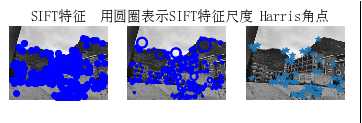






3、两张图片,计算sift特征匹配结果
代码:
1 # -*- coding: utf-8 -*- 2 from PIL import Image 3 from pylab import * 4 from numpy import * 5 import os 6 7 def process_image(imagename, resultname, params="--edge-thresh 10 --peak-thresh 5"): 8 """ 处理一幅图像,然后将结果保存在文件中""" 9 if imagename[-3:] != ‘pgm‘: 10 #创建一个pgm文件 11 im = Image.open(imagename).convert(‘L‘) 12 im.save(‘tmp.pgm‘) 13 imagename =‘tmp.pgm‘ 14 cmmd = str("sift "+imagename+" --output="+resultname+" "+params) 15 os.system(cmmd) 16 print ‘processed‘, imagename, ‘to‘, resultname 17 18 def read_features_from_file(filename): 19 """读取特征属性值,然后将其以矩阵的形式返回""" 20 f = loadtxt(filename) 21 return f[:,:4], f[:,4:] #特征位置,描述子 22 23 def write_featrues_to_file(filename, locs, desc): 24 """将特征位置和描述子保存到文件中""" 25 savetxt(filename, hstack((locs,desc))) 26 27 def plot_features(im, locs, circle=False): 28 """显示带有特征的图像 29 输入:im(数组图像),locs(每个特征的行、列、尺度和朝向)""" 30 31 def draw_circle(c,r): 32 t = arange(0,1.01,.01)*2*pi 33 x = r*cos(t) + c[0] 34 y = r*sin(t) + c[1] 35 plot(x, y, ‘b‘, linewidth=2) 36 37 imshow(im) 38 if circle: 39 for p in locs: 40 draw_circle(p[:2], p[2]) 41 else: 42 plot(locs[:,0], locs[:,1], ‘ob‘) 43 axis(‘off‘) 44 45 def match(desc1, desc2): 46 """对于第一幅图像中的每个描述子,选取其在第二幅图像中的匹配 47 输入:desc1(第一幅图像中的描述子),desc2(第二幅图像中的描述子)""" 48 desc1 = array([d/linalg.norm(d) for d in desc1]) 49 desc2 = array([d/linalg.norm(d) for d in desc2]) 50 dist_ratio = 0.6 51 desc1_size = desc1.shape 52 matchscores = zeros((desc1_size[0],1),‘int‘) 53 desc2t = desc2.T #预先计算矩阵转置 54 for i in range(desc1_size[0]): 55 dotprods = dot(desc1[i,:],desc2t) #向量点乘 56 dotprods = 0.9999*dotprods 57 # 反余弦和反排序,返回第二幅图像中特征的索引 58 indx = argsort(arccos(dotprods)) 59 #检查最近邻的角度是否小于dist_ratio乘以第二近邻的角度 60 if arccos(dotprods)[indx[0]] < dist_ratio * arccos(dotprods)[indx[1]]: 61 matchscores[i] = int(indx[0]) 62 return matchscores 63 64 def match_twosided(desc1, desc2): 65 """双向对称版本的match()""" 66 matches_12 = match(desc1, desc2) 67 matches_21 = match(desc2, desc1) 68 ndx_12 = matches_12.nonzero()[0] 69 # 去除不对称的匹配 70 for n in ndx_12: 71 if matches_21[int(matches_12[n])] != n: 72 matches_12[n] = 0 73 return matches_12 74 75 def appendimages(im1, im2): 76 """返回将两幅图像并排拼接成的一幅新图像""" 77 #选取具有最少行数的图像,然后填充足够的空行 78 rows1 = im1.shape[0] 79 rows2 = im2.shape[0] 80 if rows1 < rows2: 81 im1 = concatenate((im1, zeros((rows2-rows1,im1.shape[1]))),axis=0) 82 elif rows1 >rows2: 83 im2 = concatenate((im2, zeros((rows1-rows2,im2.shape[1]))),axis=0) 84 return concatenate((im1,im2), axis=1) 85 86 def plot_matches(im1,im2,locs1,locs2,matchscores,show_below=True): 87 """ 显示一幅带有连接匹配之间连线的图片 88 输入:im1, im2(数组图像), locs1,locs2(特征位置),matchscores(match()的输出), 89 show_below(如果图像应该显示在匹配的下方) 90 """ 91 im3=appendimages(im1, im2) 92 if show_below: 93 im3=vstack((im3, im3)) 94 imshow(im3) 95 cols1 = im1.shape[1] 96 for i in range(len(matchscores)): 97 if matchscores[i]>0: 98 plot([locs1[i,0],locs2[matchscores[i,0],0]+cols1], [locs1[i,1],locs2[matchscores[i,0],1]],‘c‘) 99 axis(‘off‘) 100 101 im1f = ‘siftt/25.jpg‘ 102 im2f = ‘siftt/26.jpg‘ 103 104 im1 = array(Image.open(im1f)) 105 im2 = array(Image.open(im2f)) 106 107 process_image(im1f, ‘out_sift_1.txt‘) 108 l1,d1 = read_features_from_file(‘out_sift_1.txt‘) 109 figure() 110 gray() 111 subplot(121) 112 plot_features(im1, l1, circle=False) 113 114 process_image(im2f, ‘out_sift_2.txt‘) 115 l2,d2 = read_features_from_file(‘out_sift_2.txt‘) 116 subplot(122) 117 plot_features(im2, l2, circle=False) 118 119 matches = match_twosided(d1, d2) 120 print ‘{} matches‘.format(len(matches.nonzero()[0])) 121 122 figure() 123 gray() 124 plot_matches(im1, im2, l1, l2, matches, show_below=True) 125 show()
结果截图:
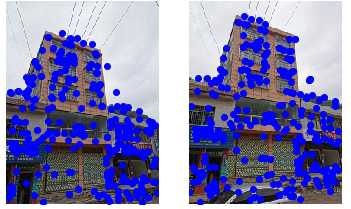
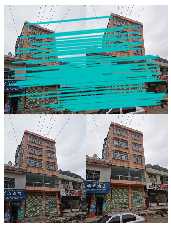
小结:用siftt算法提取两张图的特征点,然后双向匹配两张图片的描述子,用线将两幅图相匹配的描述子相连,连的线越多,说明这两幅图的匹配度越高,两幅图越相似。
4、给定一张图片,输出匹配度最高的三张图片
代码:
1 # -*- coding: utf-8 -*- 2 from PIL import Image 3 from pylab import * 4 from numpy import * 5 import os 6 from PCV.tools.imtools import get_imlist # 导入原书的PCV模块 7 import matplotlib.pyplot as plt # plt 用于显示图片 8 import matplotlib.image as mpimg # mpimg 用于读取图片 9 10 def process_image(imagename, resultname, params="--edge-thresh 10 --peak-thresh 5"): 11 """ 处理一幅图像,然后将结果保存在文件中""" 12 if imagename[-3:] != ‘pgm‘: 13 #创建一个pgm文件 14 im = Image.open(imagename).convert(‘L‘) 15 im.save(‘tmp.pgm‘) 16 imagename =‘tmp.pgm‘ 17 cmmd = str("sift "+imagename+" --output="+resultname+" "+params) 18 os.system(cmmd) 19 print ‘processed‘, imagename, ‘to‘, resultname 20 21 def read_features_from_file(filename): 22 """读取特征属性值,然后将其以矩阵的形式返回""" 23 f = loadtxt(filename) 24 return f[:,:4], f[:,4:] #特征位置,描述子 25 26 def write_featrues_to_file(filename, locs, desc): 27 """将特征位置和描述子保存到文件中""" 28 savetxt(filename, hstack((locs,desc))) 29 30 def plot_features(im, locs, circle=False): 31 """显示带有特征的图像 32 输入:im(数组图像),locs(每个特征的行、列、尺度和朝向)""" 33 34 def draw_circle(c,r): 35 t = arange(0,1.01,.01)*2*pi 36 x = r*cos(t) + c[0] 37 y = r*sin(t) + c[1] 38 plot(x, y, ‘b‘, linewidth=2) 39 40 imshow(im) 41 if circle: 42 for p in locs: 43 draw_circle(p[:2], p[2]) 44 else: 45 plot(locs[:,0], locs[:,1], ‘ob‘) 46 axis(‘off‘) 47 48 def match(desc1, desc2): 49 """对于第一幅图像中的每个描述子,选取其在第二幅图像中的匹配 50 输入:desc1(第一幅图像中的描述子),desc2(第二幅图像中的描述子)""" 51 desc1 = array([d/linalg.norm(d) for d in desc1]) 52 desc2 = array([d/linalg.norm(d) for d in desc2]) 53 dist_ratio = 0.6 54 desc1_size = desc1.shape 55 matchscores = zeros((desc1_size[0],1),‘int‘) 56 desc2t = desc2.T #预先计算矩阵转置 57 for i in range(desc1_size[0]): 58 dotprods = dot(desc1[i,:],desc2t) #向量点乘 59 dotprods = 0.9999*dotprods 60 # 反余弦和反排序,返回第二幅图像中特征的索引 61 indx = argsort(arccos(dotprods)) 62 #检查最近邻的角度是否小于dist_ratio乘以第二近邻的角度 63 if arccos(dotprods)[indx[0]] < dist_ratio * arccos(dotprods)[indx[1]]: 64 matchscores[i] = int(indx[0]) 65 return matchscores 66 67 def match_twosided(desc1, desc2): 68 """双向对称版本的match()""" 69 matches_12 = match(desc1, desc2) 70 matches_21 = match(desc2, desc1) 71 ndx_12 = matches_12.nonzero()[0] 72 # 去除不对称的匹配 73 for n in ndx_12: 74 if matches_21[int(matches_12[n])] != n: 75 matches_12[n] = 0 76 return matches_12 77 78 def appendimages(im1, im2): 79 """返回将两幅图像并排拼接成的一幅新图像""" 80 #选取具有最少行数的图像,然后填充足够的空行 81 rows1 = im1.shape[0] 82 rows2 = im2.shape[0] 83 if rows1 < rows2: 84 im1 = concatenate((im1, zeros((rows2-rows1,im1.shape[1]))),axis=0) 85 elif rows1 >rows2: 86 im2 = concatenate((im2, zeros((rows1-rows2,im2.shape[1]))),axis=0) 87 return concatenate((im1,im2), axis=1) 88 89 def plot_matches(im1,im2,locs1,locs2,matchscores,show_below=True): 90 """ 显示一幅带有连接匹配之间连线的图片 91 输入:im1, im2(数组图像), locs1,locs2(特征位置),matchscores(match()的输出), 92 show_below(如果图像应该显示在匹配的下方) 93 """ 94 im3=appendimages(im1, im2) 95 if show_below: 96 im3=vstack((im3, im3)) 97 imshow(im3) 98 cols1 = im1.shape[1] 99 for i in range(len(matchscores)): 100 if matchscores[i]>0: 101 plot([locs1[i,0],locs2[matchscores[i,0],0]+cols1], [locs1[i,1],locs2[matchscores[i,0],1]],‘c‘) 102 axis(‘off‘) 103 104 # 获取project2_data文件夹下的图片文件名(包括后缀名) 105 filelist = get_imlist(‘project2_data/‘) 106 107 # 输入的图片 108 im1f = ‘23.jpg‘ 109 im1 = array(Image.open(im1f)) 110 process_image(im1f, ‘out_sift_1.txt‘) 111 l1, d1 = read_features_from_file(‘out_sift_1.txt‘) 112 113 i=0 114 num = [0]*30 #存放匹配值 115 for infile in filelist: # 对文件夹下的每张图片进行如下操作 116 im2 = array(Image.open(infile)) 117 process_image(infile, ‘out_sift_2.txt‘) 118 l2, d2 = read_features_from_file(‘out_sift_2.txt‘) 119 matches = match_twosided(d1, d2) 120 num[i] = len(matches.nonzero()[0]) 121 i=i+1 122 print ‘{} matches‘.format(num[i-1]) #输出匹配值 123 124 i=1 125 figure() 126 while i<4: #循环三次,输出匹配最多的三张图片 127 index=num.index(max(num)) 128 print index, filelist[index] 129 lena = mpimg.imread(filelist[index]) # 读取当前匹配最大值的图片 130 # 此时 lena 就已经是一个 np.array 了,可以对它进行任意处理 131 # lena.shape # (512, 512, 3) 132 subplot(1,3,i) 133 plt.imshow(lena) # 显示图片 134 plt.axis(‘off‘) # 不显示坐标轴 135 num[index] = 0 #将当前最大值清零 136 i=i+1 137 show()
结果截图:
给定的图片

输出的图片

小结:通过用给定的图匹配图像集中的每张图片的描述子,然后用线与图像集中的图片的描述子相连,匹配度最高的图片就会被输出。
六、SIFT实验总结
1、sift算法提取特征点稳定,不会因为光照、旋转、尺度等因素而改变图像的特征点。
2、图像的尺度越大,图像就会越模糊。
3、sift算法可以对多张图像进行快速的、准确的关键点匹配,产生大量的特征点,可以适用于生活中的很多运用。
4、sift算法提取的特征点会有重叠。
5、在用sift算法提取特征时,应该降低图片的像素,像素过高会导致运行时间过长或失败。
标签:lib 影响 tool pack ack 坐标 代码 har sift
原文地址:https://www.cnblogs.com/wyf-1999-1--6/p/12442690.html